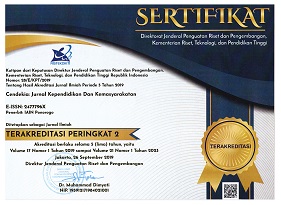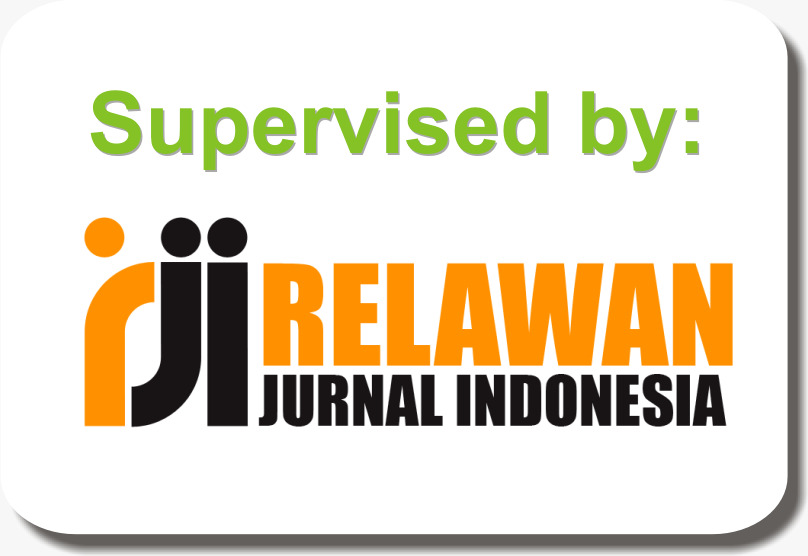Analisis Pemahaman Integral Taktentu Berdasarkan Teori APOS (Action, Process, Object, Scheme) pada Mahasiswa Tadris Matematika (TMT) IAIN Tulungagung
DOI:
https://doi.org/10.21154/cendekia.v14i1.620Keywords:
Matematika, pemahaman, integral taktentu, APOSAbstract
This research aims to describe the understanding ofmathematics Tadris students of IAIN Tulungagungabout indefinite integral understanding of APOS theory. The subjects of research are six students. Each two have high, average, and low abilities. The result of the research indicated that the understanding ofmathematics Tadris (TMT) students of IAIN Tulungagung about indefinite integral understanding on actionaspect of APOS theory, high students achieve all of understanding indicators, for average students also achieve all of understanding indicators, meanwhile for low students achieve one indicator of two indicators. On process aspect, high students achieve all of understanding indicators and average students achieve all of understanding indicators too. Meanwhile low students achieve one indicator of three indicators. On objectaspect,high students achieve all of understanding indicators and average students achieve one indicator of three understanding indicators. Meanwhile for low students do not achieve all of understanding indicators. On schemeaspect, high students achieve all of understanding indicators and for average students achieve two understanding indicators. Meanwhile for low students achieve only one indicators
Øاولت هذه المقالة عرض Ùهم طلاب قسم تعليم الرياضيات ÙÙŠ الجامعة الإسلامية الØكومية تولونج أغونج، عن التكاملات إلى أجل غير مسمّى على أساس نظرية APOS. وللوصول إلى الأهداÙØŒ اتّبع هذا البØØ« المنهج الكيÙÙŠØŒ بعرض نتائج استيعاب الÙهم على أساس نظرية APOS. ومصادر البيانات لهذا البØØ« هي ستتة طلاب: طالبان ذكيّان، وطالبان متوسطان ÙÙŠ الذكاء وطالبان ضعيÙان. دلت نتائج البØØ« على أن Ùهم طلاب تدريس الرياضيات ÙÙŠ الجامعة الإسلامية الØكومية تولونج أغونج عن التكاملات إلى أجل غير مسمّى ÙÙŠ مرØلة التطبيق كان الطالبان الذكيان توÙّرت Ùيهما جميع مؤشرات الÙهم، وتوÙّر جميع مؤشّرات الÙهم كذلك ÙÙŠ الطالبين المتوسطين ÙÙŠ الذكاء، أما ÙÙŠ الطالبين الضعيÙين ÙتوÙّرت Ùيهما مؤشّرة واØدة Ùقط. وأما ÙÙŠ مرØلة العملية Ùإن الطالبين الذكيّين توÙّرت Ùيهما جميع مؤشرات الÙهم، ÙˆÙÙŠ الطالبين المتوسطين ذكاء ÙتوÙّر Ùيهما جميع مؤشرات الÙهم كذلك، أما ÙÙŠ الطالبين الضعيÙين ÙتوÙّرت Ùيهما مؤشرة واØدة Ùقط من ثلاث مؤشرات. ÙˆÙÙŠ مرØلة الموضوع، Ùإن الطالبين الذكيين توÙّر Ùيهما جميع مؤشرات الÙهم، والطالبان المتوسطان ÙتوÙّر Ùيهما مؤشرة واØدة Ùقط من ثلاث مؤشرات الÙهم، وأما الطالبان الضعيÙان Ùلا تتوÙّر Ùيهما أية مؤشرة من ثلاث مؤشرات الÙهم. وأما ÙÙŠ مرØلة التخطيط Ùإن الطالبين الذكيين توÙّرت Ùيهما جميع مؤشرات الÙهم، ÙˆÙÙŠ الطالبين المتوسطين توÙرت Ùيهما مؤشرتان Ùقط، وأما ÙÙŠ الطالبين الضعيÙين ÙتوÙّرت Ùيهما مؤشرة واØدة Ùقط
Downloads
Published
Issue
Section
License
Copyright & License
Please find the rights and licenses in Cendekia: Jurnal Kependidikan dan Kemasyarakatan. By submitting the article/manuscript, the author(s) agree with this policy. No specific document sign-off is required.
1. License
The non-commercial use of the article will be governed by the Creative Commons Attribution license as currently displayed on the Creative Commons Attribution-NonCommercial 4.0 International License.
2. Author(s)' Warranties
The author warrants that the article is original, written by the stated author(s), has not been published before, contains no unlawful statements, does not infringe the rights of others, is subject to copyright that is vested exclusively in the author and free of any third party rights, and that any necessary written permissions to quote from other sources have been obtained by the author(s).
3. User/Public Rights
The spirit of Cendekia: Jurnal Kependidikan dan Kemasyarakatan is to disseminate articles published as free as possible. Under the Creative Commons license, Cendekia: Jurnal Kependidikan dan Kemasyarakatan permits users to copy, distribute, display, and perform the work for non-commercial purposes. Users will also need to attribute authors and Cendekia: Jurnal Kependidikan dan Kemasyarakatan on distributing works in the journal and other media of publications. Unless otherwise stated, the authors are public entities as soon as their articles got published.
4. Rights of Authors
Authors retain all their rights to the published works, such as (but not limited to) the following rights;
- Copyright and other proprietary rights relating to the article, such as patent rights,
- The right to use the substance of the article in own future works, including lectures and books,
- The right to reproduce the article for own purposes,
- The right to self-archive the article,
- The right to enter into separate, additional contractual arrangements for the non-exclusive distribution of the article's published version (e.g., post it to an institutional repository or publish it in a book), with an acknowledgment of its initial publication in this journal (Cendekia: Jurnal Kependidikan dan Kemasyarakatan).
5. Co-Authorship
If the article was jointly prepared by more than one author, any author submitting the manuscript warrants that he/she has been authorized by all co-authors to be agreed on this copyright and license notice (agreement) on their behalf and agrees to inform his/her co-authors of the terms of this policy. Cendekia: Jurnal Kependidikan dan Kemasyarakatan will not be held liable for anything arising due to the author(s) internal dispute. Cendekia: Jurnal Kependidikan dan Kemasyarakatan will only communicate with the corresponding author.
6. Royalties
Being an open accessed journal and disseminating articles for free under the Creative Commons license term mentioned, the author(s) are aware that Cendekia: Jurnal Kependidikan dan Kemasyarakatan entitles the author(s) to no royalties or other fees.
7. Miscellaneous
Cendekia: Jurnal Kependidikan dan Kemasyarakatan will publish the article (or have it published) in the journal if the article's editorial process is completed. The editors of Cendekia: Jurnal Kependidikan dan Kemasyarakatan may modify the paper to a style of punctuation, spelling, capitalization, referencing, and usage that deems appropriate. The author acknowledges that the article may be published so that it will be publicly accessible, and such access will be free of charge for the readers, as mentioned in point 3.

















